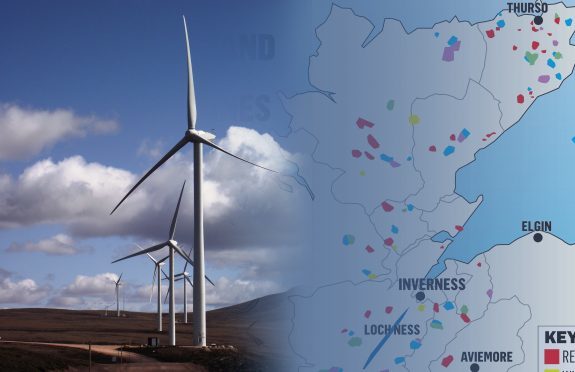The true scale of the spread of windfarms across the north of Scotland can be revealed today in a new map.
Leading anti-windfarm campaigners branded it “truly shocking” last night, and a “depressing illustration” of the impact of turbines.
And it sparked fresh calls for action to limit the proliferation of the controversial developments “springing up all over our hills and glens”, amid claims that the Scottish Government should be “ashamed” of the image.
But Holyrood insisted it was committed to “striking a balance” between making the most of renewable energy and protecting the environment.
One of the most striking features in the new map is the so-called “Ring of Steel”, which is clearly illustrated in the hills above and around the iconic Loch Ness.
The largest development is the huge offshore Beatrice windfarm, which will involve 180 turbines being erected in the Moray Firth, off the Caithness coast.
Beauly-based anti-windfarm campaigner Lyndsey Ward said the scale of the developments was shocking.
“The scale and pace of development allowed in the Highlands has been truly shocking,” she said.
“For years campaigners have warned that it was far too much and take no pleasure in being proved right as hundreds of giant turbines are springing up all over our hills and glens.
“The Scottish Government has been driving the gravy train for the subsidy hunting developers and should be ashamed of the devastation they have presided over.”
Pat Wells of the Save Strathdearn campaign group said the reality could be concerning.
“The map presents a depressing illustration of how many of the most scenic landscapes in Highland are now degraded by inappropriate industrial development – a serious indictment of previous and current SNP ministers who care nothing for one of Highland’s most precious assets,” she said.
She highlighted that the local authority’s map does not give the number of turbines for each development in written information.
“This is particularly important where extensions are involved, modifications and where there are new developments adjacent to existing developments.
“This information would provide a clearer picture of the tonnes of steel, concrete and rare earth minerals required for these environmentally damaging developments – facts which developers and many politicians prefer the public to remain in ignorance.”
Stephanie Clark, policy manager at Scottish Renewables, said: “This updated map is a really useful tool for anyone interested in wind farm development in the Highlands, and its clarity and accessibility are to be welcomed.
“Information like this enables everyone to clearly see the extent of existing, planned and refused wind farm developments.
“Onshore wind, which is currently supported by a record high of 71% of people, provides the bulk of Scotland’s green energy capacity cheaply, predictably and alongside a whole raft of other social, environmental and economic benefits.”
A Scottish Government spokesman said: “We have clear planning policies in place to ensure wind farms are developed in appropriate locations.
“Whilst we need to pursue Scotland’s vast potential to generate power from renewable sources, it is equally clear that we need to do this in a way that protects Scotland’s magnificent natural environment.
“That will always be the basis of our renewable energy policies and we will go on striking that balance, working with partners across the energy, environment and tourism sectors and ensure that they all thrive.
“Environmental impacts are always important in our determinations and to further this in our recently published draft Onshore Wind Policy Statement we consider the efficiency of new wind farms in the consenting procedure where we have a call for evidence on the appropriate approach to include wind farm efficiency as a material consideration.”
A spokeswoman for Highland Council said: “Our wind turbine mapping is a useful information source for the general public to view the patterns of built and proposed wind farms throughout the area, and is generally well received.
“It is an interactive map that when used correctly provides a great deal of information on each scheme.”
